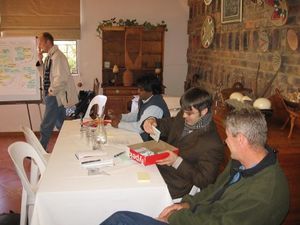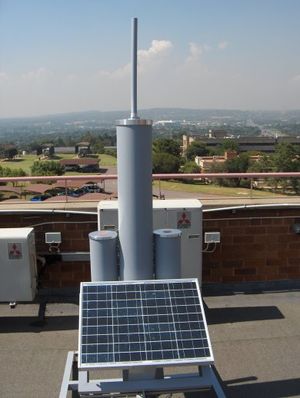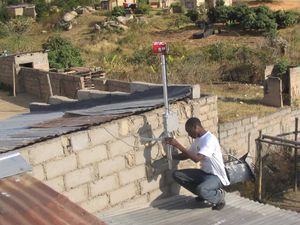Wireless Africa Home Page

|
| The Wireless Africa group is researching ways and means to develop sustainable information and communications technology in developing countries. This will be achieved through community-owned decentralized mesh networks built on open source technology |
1 May 2007 Wireless Africa road map process underway

A number of workshops were hold with staff at Meraka to understand our vision and what our research, development and product offerings will be.
- The first workshop, held on the 18th of May 2007, helped us to understand where we've come from and what our vision is for the future. Our current vision statement is:
| Make a significant contribution to connecting 450 million people sustainably in rural Africa through wireless mesh and other technology with a community grown philosophy |
- The second workshop, held on the 8th of June 2007, helped us understand what our three main product offerings will be
- Africa mesh node (Multi radio node with customized hardware and specialized firmware)
- DIY mesh kit (Low cost single radio node available off the shelf with specialized firmware)
- WISP in a box (Bandwidth and user management tool which makes it simple for somebody to set up a wireless business)
- The third workshop, held on the 14th of June, was a follow up on the second workshop which tried to define the milestones needed to improve the functionality of each of these product offerings over a 3 year period (See link below for more detail).
The plan is to have a first draft of this road map by the end of July
More information can be found here: Wireless Africa Roadmap . We strongly urge other researchers in the field to comment on this roadmap
10 December 2006 Prototype 1 of fully self-contained solar powered SA mesh node

The first prototype of a multi antenna self-contained mesh node was unveiled in December 2006. This nodes operates on a 45W solar panel to power the embedded computer and three 802.11 radios. The backhaul mesh is built in the 5GHz band using 2 radios which can be switched through a matrix of 4 antennas. This allows a full duplex connection on the backhaul. The Switachable antenna matrix consists of 4 5GHz panel antennas placed at 90 degrees to each other within a weather proof cylinder. An intelligent switching algorithm is used to switch through the four antennas and locate the other mesh nodes in the network. Switching happens as soon as traffic needs to be routed between mesh nodes. A 2.4GHz band radio connected to an omni is used to connect clients to the mesh node.
More Information on the SA mesh node
1 October 2006 Tin can connects rural home to outside world
The Meraka Institute's first Cantenna installed in a rural setting was successfully mounted onto the house of Agnes Mdluli, a health worker from Peebles valley, near White River in Mpumalanga. This can-antenna is made from a metal can, such as a coffee tin, and a section of bicycle spoke soldered into a special connector which can connect to another point with a similar antenna up to 5km away. The project in Peebles Valley is one of 10 sub-projects in the First Mile First Inch (FMFI) project being funded by the International Development Research Centre (IDRC).
These small, self-constructed antennas, which are made from locally available material, are connected to a low-cost WiFi card plugged into a computer. A small wireless router is placed in a weatherproof casing on a pole to which several community members could connect and form a community mesh network. This mesh networking technology allows the wireless installations to automatically configure themselves to find the optimal routes through the network and very little configuration is needed to set them up.
More information can be found here: Mpumulanga Mesh and FMFI Mpumalanga Mesh

NEW: Quick getting started guide for setting up an outdoor mesh node
Please use the discussion tag above to comment and provide suggestions!
Please Email wa-admin(at)meraka.org.za if you wish to contribute or for further information.
